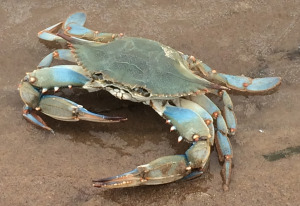Posted noon Thursday, Dec. 11, 2014

A Chesapeake blue crab — native to the western Atlantic Ocean and Gulf of Mexico — somehow found its way into the cool, northern waters of the Mississippi River this fall.
 It’s not uncommon for other invasive species like the zebra mussel to travel on barges, so why not a blue crab?, notes UW-L instructor Carol Witt-Smith. Her students found this Chesapeake blue crab on Airport Beach on French Island in November.[/caption]
A Chesapeake blue crab — native to the western Atlantic Ocean and Gulf of Mexico — somehow found its way into the cool, northern waters of the Mississippi River this fall.
Several UW-L students found the crab in mid November on French Island while doing a video project for their scientific methods class.
The students: Abbey Johnson and Brittany Kujath, both a senior education major; and Katie Mabery, a graduate student in Therapeutic Recreation, were at Airport Beach on French Island when they spotted the crab moseying along the shoreline. They decided to name the crab “Brabbie,” a combination of all of their names.
How the crab made it more than 1,000 miles through river dams well outside its native habitat is a bit of a mystery, says their instructor Carol Witt-Smith, academic instructional staff member in Educational Studies. Both she and her students agree the most likely scenario is that Brabbie hitched a ride north on a barge. The crab also could have been released as an unwanted pet.
Regardless of how it arrived, Witt-Smith is curious to know if others have spotted blue crabs in the area.
Brabbie was alive when the students found it. Not realizing the crab was so far from home, they left it and told Witt-Smith about it the next day. When she returned to the beach, the crab had not survived the night. Witt-Smith brought the crab to the U.S. Fish and Wildlife Service where it is being held for further identification.
The Chesapeake blue crab produces a sweet, tender meat which makes it one of the most heavily harvested creatures on the planet, according to a National Geographic description. According to the website, many populations of Chesapeake blue crabs have experienced severe declines and over-harvesting has had a negative effect on the ecosystems where they live.
It’s not uncommon for other invasive species like the zebra mussel to travel on barges, so why not a blue crab?, notes UW-L instructor Carol Witt-Smith. Her students found this Chesapeake blue crab on Airport Beach on French Island in November.[/caption]
A Chesapeake blue crab — native to the western Atlantic Ocean and Gulf of Mexico — somehow found its way into the cool, northern waters of the Mississippi River this fall.
Several UW-L students found the crab in mid November on French Island while doing a video project for their scientific methods class.
The students: Abbey Johnson and Brittany Kujath, both a senior education major; and Katie Mabery, a graduate student in Therapeutic Recreation, were at Airport Beach on French Island when they spotted the crab moseying along the shoreline. They decided to name the crab “Brabbie,” a combination of all of their names.
How the crab made it more than 1,000 miles through river dams well outside its native habitat is a bit of a mystery, says their instructor Carol Witt-Smith, academic instructional staff member in Educational Studies. Both she and her students agree the most likely scenario is that Brabbie hitched a ride north on a barge. The crab also could have been released as an unwanted pet.
Regardless of how it arrived, Witt-Smith is curious to know if others have spotted blue crabs in the area.
Brabbie was alive when the students found it. Not realizing the crab was so far from home, they left it and told Witt-Smith about it the next day. When she returned to the beach, the crab had not survived the night. Witt-Smith brought the crab to the U.S. Fish and Wildlife Service where it is being held for further identification.
The Chesapeake blue crab produces a sweet, tender meat which makes it one of the most heavily harvested creatures on the planet, according to a National Geographic description. According to the website, many populations of Chesapeake blue crabs have experienced severe declines and over-harvesting has had a negative effect on the ecosystems where they live.
